How Sustainability and Generative AI Fuel Sustainable Innovation
“AI is reshaping industries, enhancing efficiency & productivity, and pushing the limits of what is possible. As a result, the job market is evolving, and while some jobs will become automated, new opportunities will arise. The future of work will involve humans collaborating with AI to accomplish tasks more efficiently. Therefore, organizations must reskill and upskill their workforce to ensure individuals possess the necessary abilities to thrive in this AI-driven future. To keep up with AI and adapt to unpredictable circumstances, Personal Disruptive Innovation is essential in developing critical thinking skills, future-proofing our careers, and allowing us to thrive in this future”. – Hubert Rampersad.
Innovation is constantly evolving, and with generative AI being the latest wave, humans must focus on personal disruptive innovation to keep up and support AI. It’s important to note that while generative AI is a valuable tool, it cannot replace human intelligence, empathy, integrity, and critical thinking. Combining personal disruptive innovation with generative AI can help us generate more imaginative, innovative, empathetic, and disruptive ideas. With generative AI being the newest innovation, it is essential to concentrate on personal disruptive innovation to keep up with and aid generative AI. Please read my article “Cultivating Critical Thinking in the Age of AI“.
On the other hand, the pandemic has taught us valuable lessons, including the need for a better world characterized by empathy, personal integrity, non-racialism, environmental responsibility, efficiency, circularity, a revised role for human resources, good governance, and ethical leadership. This better world should prioritize sustainability in design innovation, HR, leadership, diversity and inclusion, corporate governance, and higher education. The accompanying Figure illustrates this.

“Sustainability involves a holistic and ethical approach that aims to establish a harmonious coexistence between humans and nature for an extended period.”-– Hubert Rampersad.
“Empathy is the key to improving the world for animals and humans. Personal integrity is the foundation of empathy, which requires putting aside one’s ego. The higher one’s personal integrity, the more attentive and empathetic one becomes. This leads to better design and ultimately happier customers”—Hubert Rampersad.
“The approach to addressing climate change is wrong as it only focuses on the symptoms rather than the root causes. Educating individuals on the significance of personal integrity and how our actions impact the environment, including all living beings, is vital. Empathy is crucial in establishing a strong foundation for environmental consciousness, which starts with personal integrity. To combat climate change effectively, we need good people. Still, unfortunately, the world is full of bad people, which may explain why only a few individuals are actively involved in the fight against climate change”.—Hubert Rampersad.
Sustainability begins with the individual. It starts with personal integrity and empathy. The initial step towards sustainability involves aligning oneself with one’s actions and continuously being conscious of their impact on humans, animals, plants, and the environment. This practice involves personal integrity, empathy, eco-design thinking, and eco-innovation. For further information, please refer to my article “How SDGs, ESG, and Purpose Fuel Circular & Value-based Design For Sustainability.”
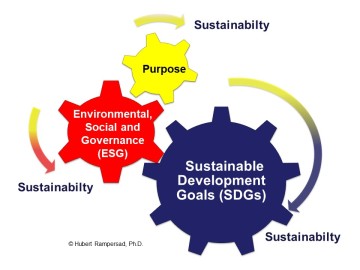
Read “10 Ways to Kill Creativity, Sustainability, and Innovation”.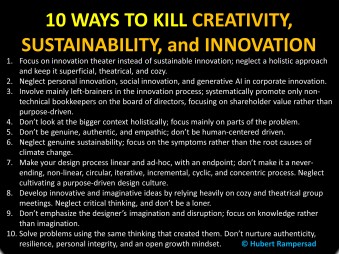
The era of design thinking has come to an end. Read my article “The End of Design Thinking: Cultivating a Purpose-Driven Design Culture to Fix the World”. Eco-design thinking goes beyond traditional design thinking. It is based on my latest book, “Eco- Design Thinking for Personal, Corporate, and Social Innovation.” To design a better world, we must adopt new design methods and ways of thinking. As Einstein famously stated, “We cannot solve our problems with the same thinking we used when we created them.” That’s where eco-design thinking emerges, shifting from the traditional fixed mindset to a more dynamic growth mindset. The difference between these two approaches is illustrated in the figure below.
Design Thinking for Personal, Corporate, and Social Innovation.” To design a better world, we must adopt new design methods and ways of thinking. As Einstein famously stated, “We cannot solve our problems with the same thinking we used when we created them.” That’s where eco-design thinking emerges, shifting from the traditional fixed mindset to a more dynamic growth mindset. The difference between these two approaches is illustrated in the figure below.
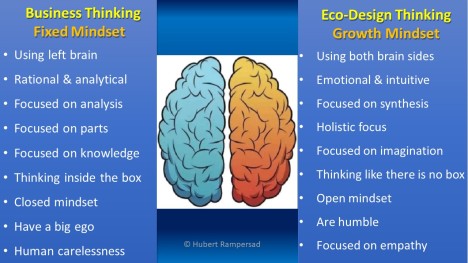
Many individuals favor their brain’s left side and ignore the right, resulting in a lack of balance. This limits their ability to approach complex design issues creatively and with authenticity. To help with this, this article presents a comprehensive framework and tools to become an empathetic and innovative eco-design thinker. This aligns with my eco-innovation model, which is explained in detail below.
Sustainable Innovation
In today’s complex world, sustainable innovation is crucial. Traditional innovation approaches are inadequate because they lack a holistic approach. Instead, they are superficial, theatrical, and cozy. Such policies do not align with my definition of genuine sustainability, which entails a holistic and ethical system that fosters long-term coexistence between humans and nature. This is why I introduced my Eco-Innovation concept.
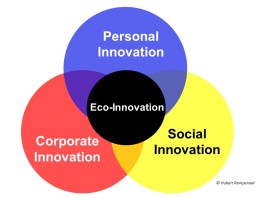
Eco-Innovation involves integrating sustainability into the process of innovation. I identify three types of innovation that fall under this category:
- Personal innovation unlocks your creative potential and creates new opportunities for yourself. By disrupting your current market, you can make a significant social impact. Personal Disruptive Innovation by Hubert Rampersad also helps you find your purpose and improve your business and personal life for greater happiness and health.
- Corporate innovation involves applying new ideas to create new products, processes, or services that increase the value of a company. Corporate innovation also encompasses Open Innovation by Chesbrough, Disruptive Innovation by Clayton Christensen, and BlockChain Innovation.
- Social innovation is developing and implementing new ideas and solutions that meet social needs and strengthen civil society. There is some overlap between social innovation and social entrepreneurship. Social innovation aims to improve the world by implementing innovative ideas that create social and environmental change, benefiting many people. Social entrepreneurs seek the most effective ways to achieve their social mission and provide social benefits.
The diagram below shows how personal, corporate, and social innovation are interconnected. Personal innovation is linked to self-learning, corporate innovation is related to organizational learning, and social innovation is linked to community learning.
Innovative Ideas
Traditional design thinking approaches are unsuitable for a sustainable circular economy as they focus on process-driven, analytical thinking, cozy, theatrical meetings, and completing related tasks in a particular order using design tools. These approaches lack imagination and fail to address the larger picture. Remember what Albert Einstein said: “The true sign of intelligence is not knowledge but imagination. Logic will get you from A to B. But imagination will take you everywhere… When I examine myself and my methods of thought, I conclude that the gift of fantasy has meant more to me than any talent for abstract, positive thinking… The intuitive mind is a sacred gift, and the rational mind is a faithful servant. We have created a society that honors the servant and has forgotten the gift.”
The best ideas come when you are alone. Self-learning – the ability to gather, process, retain, and evaluate knowledge alone, as discussed in my article “Why Creativity Sucks— is the foundation of creativity and imagination. 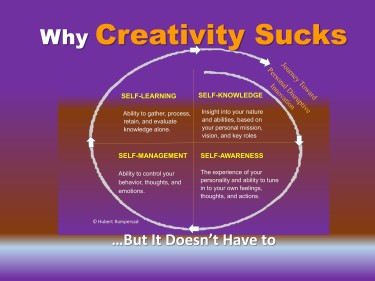
Traditional creativity approaches lack imagination because they neglect self-learning and, because of this, fail to address complex problems. They heavily rely on group meetings and, therefore, miss opportunities to develop innovative and imaginative ideas. These cozy meetings are unnecessary for generating creative ideas. In fact, research suggests that p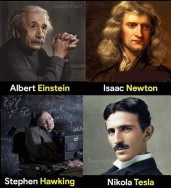 eople tend to be more creative when working alone than in groups. Some of the best ideas have been generated by individuals working independently. For instance, Nikola Tesla developed many innovative ideas while working alone for over thirty years. Similarly, Stephen Hawking made significant discoveries while confined to his wheelchair, and Isaac Newton famously discovered gravity while in social isolation.
eople tend to be more creative when working alone than in groups. Some of the best ideas have been generated by individuals working independently. For instance, Nikola Tesla developed many innovative ideas while working alone for over thirty years. Similarly, Stephen Hawking made significant discoveries while confined to his wheelchair, and Isaac Newton famously discovered gravity while in social isolation.
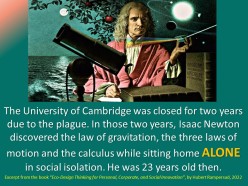 Remember Nikola Tesla’s statement: “Being alone is when ideas are born. This is the secret of innovation”. Albert Einstein said almost the identical: “Be a loner. That gives you time to wonder, to
Remember Nikola Tesla’s statement: “Being alone is when ideas are born. This is the secret of innovation”. Albert Einstein said almost the identical: “Be a loner. That gives you time to wonder, to search for the truth. Have holy curiosity. Make your life worth living”.
search for the truth. Have holy curiosity. Make your life worth living”.
In the following section, I will discuss the concept of personal disruptive innovation, which offers a way to cultivate creativity while working alone, without the need for in-person brainstorming sessions. By utilizing eco-design thinking, you can generate great ideas using only yourself.
Personal Disruptive Innovation Framework and Roadmap
Personal disruptive innovation is an innovative approach that unlocks your creative potential by cultivating a strong growth mindset, creating new unique opportunities, disrupting your current target market, and allowing you to make a significant social impact. This model involves five steps to promote authenticity, integrity, and sustainability, as shown in this model: 1. Personal Ambition, 2. Personal Brand, 3. Personal Innovation Strategy, 4. Implementation, and 5. Personal Integrity & Empathy.
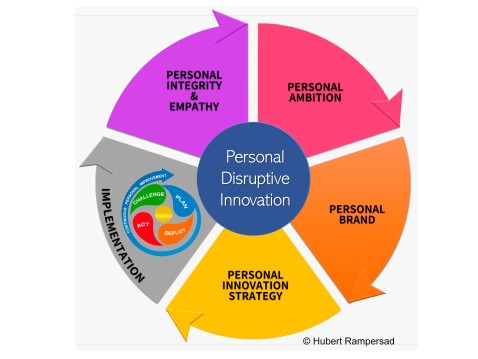
My article “Personal Disruptive Innovation” describes this model in detail. To be discussed in the next section, the eco-design thinking model starts with personal disruptive innovation to understand, explore, redefine, and redesign yourself before solving the design problem. You need to become innovative and empathic first to develop innovative designs for the end users. You need to develop disruptive skills first. You need to reinvent and redesign yourself first to become a disruptor. In the upcoming section, I will discuss the eco-design thinking model, which emphasizes personal disruptive innovation as the first step towards understanding, exploring, redefining, and redesigning oneself before solving any design problems. Being innovative and empathic is essential to developing innovative designs that cater to the end users’ needs. Therefore, developing disruptive skills and reinventing oneself to become a disruptor is necessary.
Personal disruptive innovation can unlock your creative potential, open up new, unique opportunities, challenge traditional markets, and allow you to make a meaningful impact on society. You can break free from conventional thinking and expand your horizons by embracing innovation. In this way, you will not think outside the box; you will think like there is no box. 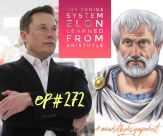 The roadmap for personal innovation begins with personal ambition, founded on self-knowledge. It’s important to remember that All knowledge begins with self-knowledge, all learning begins with self-learning, all innovation starts with self-innovation (personal innovation), and authentic empathy begins with personal integrity. Self-knowledge involves knowing oneself. Remember what Aristotle said: “Knowing yourself is the beginning of all wisdom.” Elon Musk learned a lot from Aristotle. Remember, “To be more innovative and creative, individuals should focus more on cultivating self-knowledge.”. –– Hubert Rampersad.
The roadmap for personal innovation begins with personal ambition, founded on self-knowledge. It’s important to remember that All knowledge begins with self-knowledge, all learning begins with self-learning, all innovation starts with self-innovation (personal innovation), and authentic empathy begins with personal integrity. Self-knowledge involves knowing oneself. Remember what Aristotle said: “Knowing yourself is the beginning of all wisdom.” Elon Musk learned a lot from Aristotle. Remember, “To be more innovative and creative, individuals should focus more on cultivating self-knowledge.”. –– Hubert Rampersad.
By defining your personal mission, vision, and critical roles, you can uncover your true purpose and understand the meaning of your life. Remember what Elon Musk, the disruptor, said: “Don’t even attach yourself to a person, a place, a company, an organization, or a project. Attach yourself to a mission, a calling, a purpose only. That’s how you keep power and your peace. It worked pretty well for me this far”.
Personal Disruptive Innovation and Generative AI
With generative AI being the newest innovation, it is essential to concentrate on personal disruptive innovation to keep up with and aid generative AI. Read the recent Harvard Business Review Article “How Generative AI Can Augment Human Creativity”, which explored the potential of different generative AI tools to stimulate creative thinking by merging numerous ideas to generate even stronger ones. These AI tools can encourage the exploration of new problem-solving methods, create innovative solutions, and assist in evaluating ideas using ChatGPT. Additionally, they can support the refinement of ideas and facilitate collaboration among end-users. However, the article omitted the crucial aspect of holistically integrating these AI tools into a new holistic design process to use them effectively.
You can now create your own custom ChatGPTbot. Designers can leverage GPTs to enhance the customer experience by delivering personalized recommendations and content. The customized AI algorithms can analyze user behavior and preferences to increase user engagement and satisfaction. By understanding the user better, designers can make better decisions about product features and improvements. Customized AI refers to developing and implementing AI solutions specifically tailored to a design team’s unique needs and goals. These solutions can range from AI-powered tools that aid market research and product design to AI-driven analytics platforms that provide real-time insights. GPTs are tailored versions of OpenAI’s ChatGPT.
It is widely understood that generative AI will not replace humans entirely. Therefore, it is essential to ensure that humans can work alongside these innovative tools in harmony and efficiently use them. Launching a new comprehensive and holistic design thinking model, including the personal disruptive innovation methodology, that integrates generative AI and genuine sustainability would be worthwhile.
Is it not better to begin the new design process by first developing innovative, intelligent, truthful, and empathic designers who can use generative AI optimally in the later stages? It seems odd that traditional design models neglect this crucial initial step and instead prioritize empathizing with end users. Shouldn’t we revise the design process to create a more sustainable world in the age of generative AI? In the following section, I will introduce a new design model to help companies, academic institutions, governments, and militaries make better use of generative AI in their design process. This will lead to more innovative, imaginative, disruptive, empathetic, and creative ideas.
Eco-Design Thinking Model: A Generative AI-Friendly Design Process
My article “Top-10 Causes of Bad Designs” highlights the negative impact of bad designs due to a lack of consideration for sustainability, personal disruptive innovation, and generative AI. Some well-known examples of such methods include the botched vaccine rollout in America and Citibank’s loss of $500 million due to an unfriendly loan.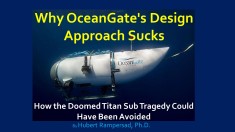 Management tool, the $2 trillion F-35 project, the Boeing 737 Max airplane, the T-14 Armata Russian Tank, and the Samsung Galaxy Note 7. Please take the time to read my article “Why OceanGate’s Design Approach Sucks; How the Doomed Titan Sub Tragedy Could Have Been Avoided.” CEOs who prioritize their personal design choices over critical safety regulations, endangering human lives, can learn a valuable lesson from the tragedy of the Titan. This also applies to individuals like Elon Musk and companies like Boeing. Please look at my article “How could Elon Musk’s $3 billion Mars rocket failure have been avoided?”.
Management tool, the $2 trillion F-35 project, the Boeing 737 Max airplane, the T-14 Armata Russian Tank, and the Samsung Galaxy Note 7. Please take the time to read my article “Why OceanGate’s Design Approach Sucks; How the Doomed Titan Sub Tragedy Could Have Been Avoided.” CEOs who prioritize their personal design choices over critical safety regulations, endangering human lives, can learn a valuable lesson from the tragedy of the Titan. This also applies to individuals like Elon Musk and companies like Boeing. Please look at my article “How could Elon Musk’s $3 billion Mars rocket failure have been avoided?”.
Top 10 causes of bad designs:
- INCOMPETENT DESIGNERS: Designers don’t use their right and left brains in a balanced way, lacking an intuitive, open, empathic, ethical, and growth mindset.
- DESIGN PROCESS HAS ENDPOINT: The design process should be a never-ending, non-linear, circular, iterative, incremental, cyclic, and concentric process that never stops.
- NON-HOLISTIC DESIGN APPROACH: The design method should prioritize cultivating a purpose-driven design culture that positively impacts society.
- FOCUS ON KNOWLEDGE RATHER THAN IMAGINATION: The design method should take an inside-out approach to creativity, emphasizing the designer’s imagination.
- DESIGNERS LACK GENUINE EMPATHY AND PERSONAL INTEGRITY: The higher your personal integrity, the better your attentiveness, the better your empathic skills, the better your design. Genuine empathy starts with personal integrity.
- NON-DISRUPTIVE DESIGNERS: The design method should start with designing the designer’s life to become disruptive with a growth-open mindset.
- DOES NOT FACILITATE THE USE OF GENERATIVE AI: Designers lack critical thinking skills to use generative AI tools like Stable Diffusion and ChatGPT to create novel designs.
- BAD DESIGN LEADERS: Design leaders lack the coaching skills to cultivate team learning and enhance team performance.
- DISENGAGED DESIGN TEAMS: To enhance the designer’s engagement, aligning and synchronizing the designer’s ambition with the design team’s ambition is needed.
- COZY DESIGN MEETINGS AND USE OF TOOLS: The design method focuses mainly on a process-driven, analytical thinking, cozy, theatrical design process and completing related tasks in a particular order using design tools.
The figure below illustrates the top 10 reasons behind these bad designs.

We must adopt a new design method that is better suited for generative AI to design a more sustainable world. This method should prioritize creating intelligent, resilient, empathetic, and honest designers. To achieve this goal, I have introduced eco-design thinking. This creative process involves empathizing with yourself, the end user, and the environment to generate innovative, imaginative, empathetic, and disruptive design ideas. The new design model consists of four stages: Explore, Ideate, Prototype, and Execute. It is an iterative, incremental, cyclic, and concentric process of exploring, ideating, prototyping, and executing. Eco-design thinking is a circular and iterative process that has no endpoint. The model consists of various stages that may form iterative loops and do not need to follow a specific sequence. Read my article “How Generative AI Helps Design a Better World. This article is based on my experience as senior design innovation coach at ASML, the most crucial tech company in the world and “Europe’s most valuable tech firm“.
creative process involves empathizing with yourself, the end user, and the environment to generate innovative, imaginative, empathetic, and disruptive design ideas. The new design model consists of four stages: Explore, Ideate, Prototype, and Execute. It is an iterative, incremental, cyclic, and concentric process of exploring, ideating, prototyping, and executing. Eco-design thinking is a circular and iterative process that has no endpoint. The model consists of various stages that may form iterative loops and do not need to follow a specific sequence. Read my article “How Generative AI Helps Design a Better World. This article is based on my experience as senior design innovation coach at ASML, the most crucial tech company in the world and “Europe’s most valuable tech firm“. 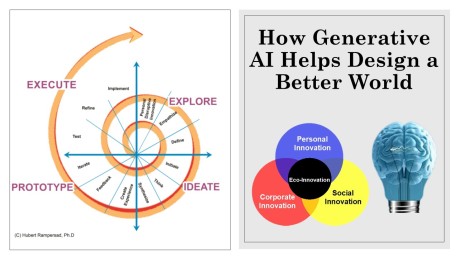
AI-powered tools that generate content can be helpful in every stage of the design process. It starts with personal disruptive innovation. If you want to learn more about the personal disruptive innovation framework and roadmap, I recommend reading my “Personal Disruptive Innovation.” Read also “Sustainable Innovation Fueled by Purpose-Driven Culture”.
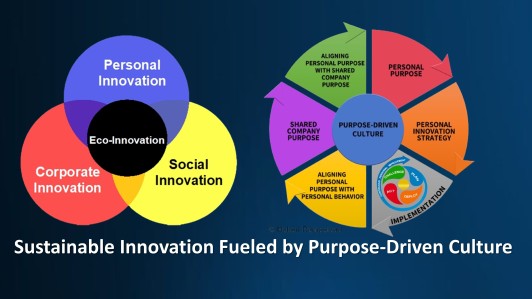
Hubert Rampersad, Ph.D.
Complimentary Initial Consultation to Enhance Your Design Process and Boost Design Team Performance
To gain more knowledge about this subject, you may consider attending his Orlando-Tampa Live Events:
Building a Purpose-Driven Design Culture in Tech Companies
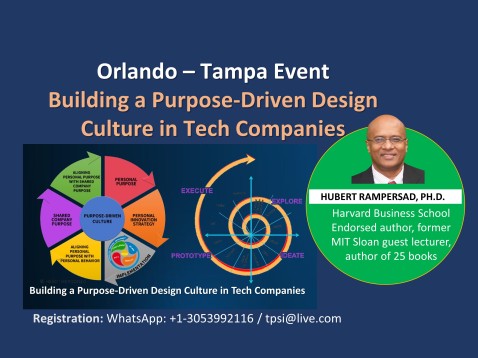
“How Sustainability and Generative AI Fuel Design Innovation”.
You may also consider attending his free live webinar, How Generative AI Helps Design a Better World.
We also offer the Certified Authentic AI Leadership Coaching program. This program is appropriate for AI leaders, managers, and professionals who wish to strengthen their ethical leadership and critical thinking skills, drive their purpose and human-centeredness, and coach others to realize the same.
Hubert Rampersad, Ph.D., founded the Center of Excellence in Human-Centered and Purpose-Driven AI Innovation in Orlando. He is a Dutch-American visionary leader in innovative solutions for genuine sustainability, disruptive design innovation, critical thinking in the age of AI, human-centered and purpose-driven AI, and entrepreneurial leadership. He holds a Ph.D. in Innovation Sciences, an MSc in Technology Engineering & Robotics, and a BSc in Mechanical Engineering from leading accredited universities in the Netherlands (Delft University of Technology, Eindhoven University of Technology). He is a well-known futurist, advocating for genuine sustainability on a global scale. With extensive knowledge and expertise, he has authored 25 books on the topics above in many languages and is highly regarded for his insights in these fields. One of his books, “Total Performance Scorecard,” has been published in 20 languages. Dorothy Leonard, an innovation professor at Harvard Business School, wrote the book’s foreword. Rampersad has also previously served as a guest lecturer at MIT Sloan and was featured in BusinessWeek. He was a senior design innovation coach at ASML, the most crucial tech company in the world and “Europe’s most valuable tech firm“.
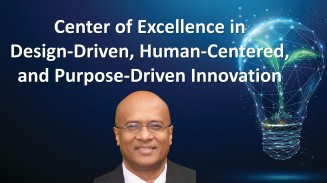
Orlando, Florida | tpsi@live.com | Phone/WhatsApp: +13053992116 | About the author https://bit.ly/2CQLIfS
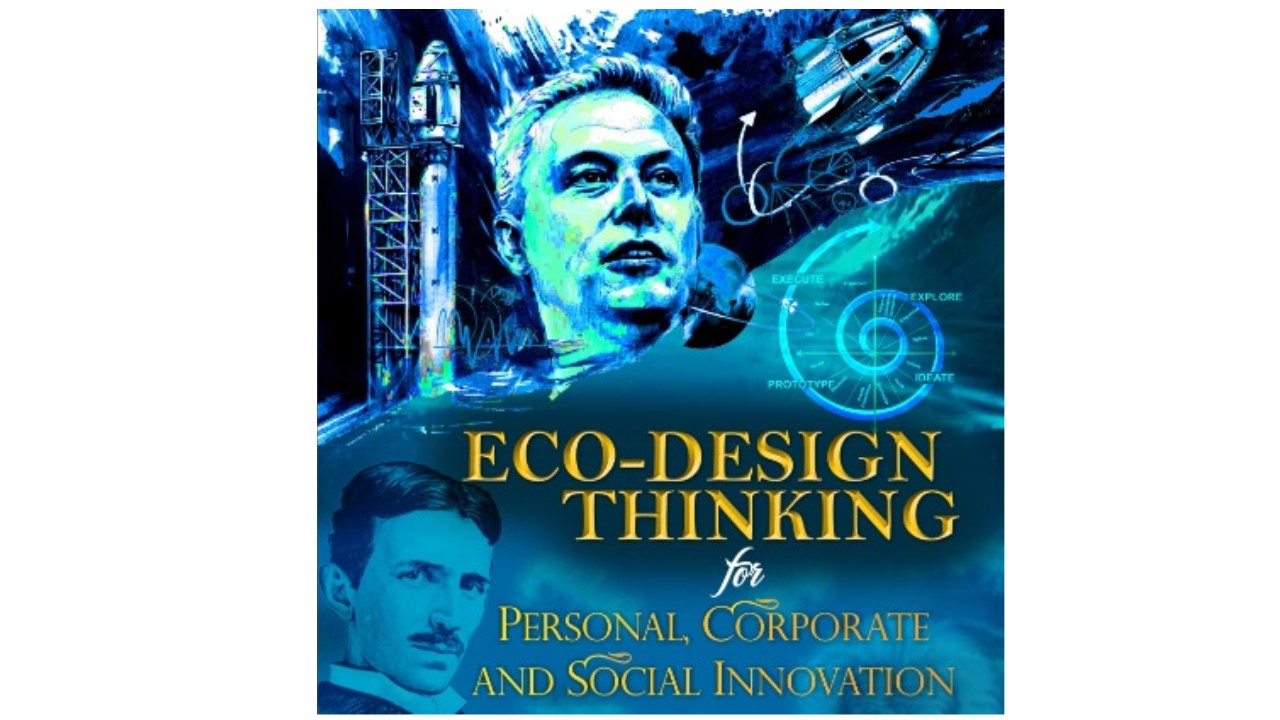
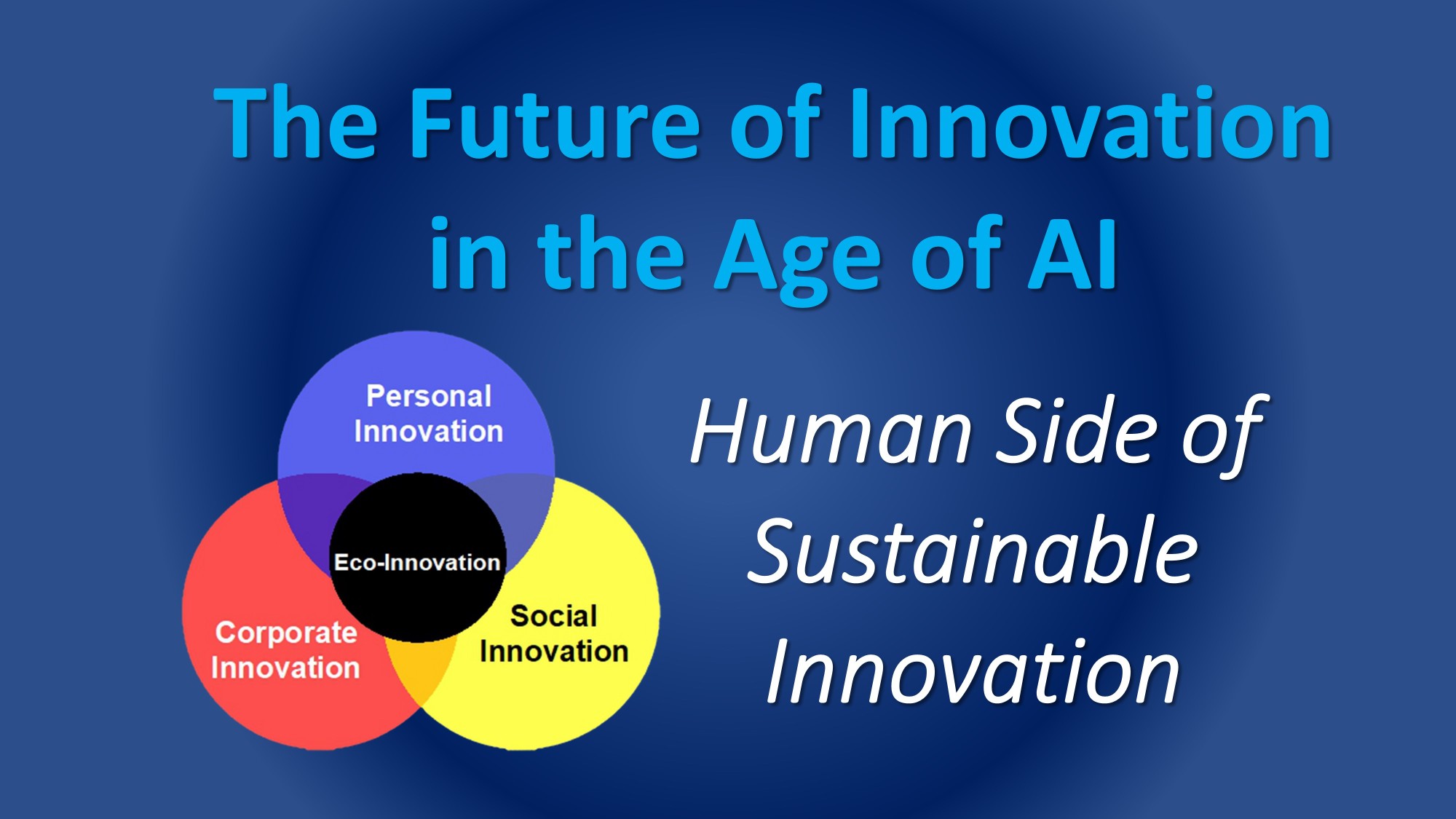
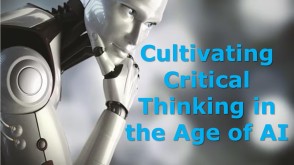


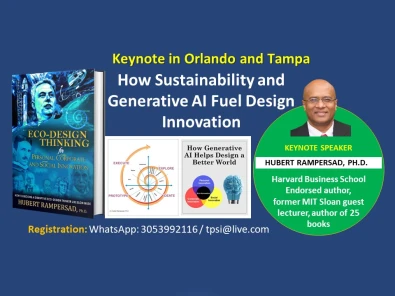
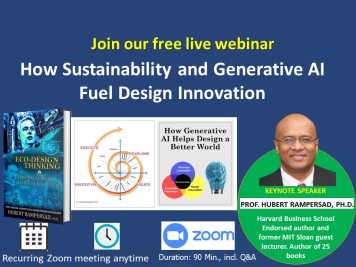
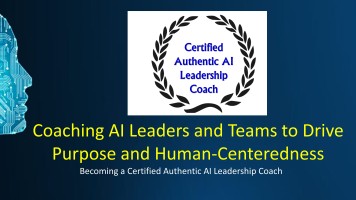
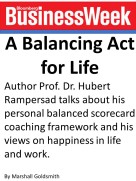

Helemaal eens Hubert. Persoonlijk merk ik dat ook. Ik zit nu in een traject wat ik zo zie onder social innovation valt. Love how you broke down in consumable pieces!
Thanks 🙂
LikeLike
I wish to get more information on this programme including requirements and fees
LikeLike